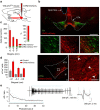Ventral tegmental area glutamate neurons co-release GABA and promote positive reinforcement
- PMID: 27976722
- PMCID: PMC5171775
- DOI: 10.1038/ncomms13697
Ventral tegmental area glutamate neurons co-release GABA and promote positive reinforcement
Abstract
In addition to dopamine neurons, the ventral tegmental area (VTA) contains GABA-, glutamate- and co-releasing neurons, and recent reports suggest a complex role for the glutamate neurons in behavioural reinforcement. We report that optogenetic stimulation of VTA glutamate neurons or terminals serves as a positive reinforcer on operant behavioural assays. Mice display marked preference for brief over sustained VTA glutamate neuron stimulation resulting in behavioural responses that are notably distinct from dopamine neuron stimulation and resistant to dopamine receptor antagonists. Whole-cell recordings reveal EPSCs following stimulation of VTA glutamate terminals in the nucleus accumbens or local VTA collaterals; but reveal both excitatory and monosynaptic inhibitory currents in the ventral pallidum and lateral habenula, though the net effects on postsynaptic firing in each region are consistent with the observed rewarding behavioural effects. These data indicate that VTA glutamate neurons co-release GABA in a projection-target-dependent manner and that their transient activation drives positive reinforcement.
Figures






Similar articles
-
Glutamatergic Ventral Pallidal Neurons Modulate Activity of the Habenula-Tegmental Circuitry and Constrain Reward Seeking.Biol Psychiatry. 2018 Jun 15;83(12):1012-1023. doi: 10.1016/j.biopsych.2018.01.003. Epub 2018 Jan 12. Biol Psychiatry. 2018. PMID: 29452828 Free PMC article.
-
Ventral pallidum GABA and glutamate neurons drive approach and avoidance through distinct modulation of VTA cell types.Nat Commun. 2024 May 18;15(1):4233. doi: 10.1038/s41467-024-48340-y. Nat Commun. 2024. PMID: 38762463 Free PMC article.
-
VTA Projection Neurons Releasing GABA and Glutamate in the Dentate Gyrus.eNeuro. 2016 Sep 13;3(4):ENEURO.0137-16.2016. doi: 10.1523/ENEURO.0137-16.2016. eCollection 2016 Jul-Aug. eNeuro. 2016. PMID: 27648470 Free PMC article.
-
Ventral pallidal modulation of aversion processing.Brain Res. 2019 Jun 15;1713:62-69. doi: 10.1016/j.brainres.2018.10.010. Epub 2018 Oct 6. Brain Res. 2019. PMID: 30300634 Review.
-
Dopamine-glutamate neuron projections to the nucleus accumbens medial shell and behavioral switching.Neurochem Int. 2019 Oct;129:104482. doi: 10.1016/j.neuint.2019.104482. Epub 2019 Jun 3. Neurochem Int. 2019. PMID: 31170424 Free PMC article. Review.
Cited by
-
Excitatory selective LTP of supramammillary glutamatergic/GABAergic cotransmission potentiates dentate granule cell firing.Proc Natl Acad Sci U S A. 2022 Mar 29;119(13):e2119636119. doi: 10.1073/pnas.2119636119. Epub 2022 Mar 25. Proc Natl Acad Sci U S A. 2022. PMID: 35333647 Free PMC article.
-
Role of laterodorsal tegmentum projections to nucleus accumbens in reward-related behaviors.Nat Commun. 2019 Sep 12;10(1):4138. doi: 10.1038/s41467-019-11557-3. Nat Commun. 2019. PMID: 31515512 Free PMC article.
-
An atlas of transcriptionally defined cell populations in the rat ventral tegmental area.Cell Rep. 2022 Apr 5;39(1):110616. doi: 10.1016/j.celrep.2022.110616. Cell Rep. 2022. PMID: 35385745 Free PMC article.
-
Rewarding Effect of Catha edulis (Khat) and the Sex Differences to the Responses in Swiss Albino Mice.Psychol Res Behav Manag. 2020 Mar 20;13:279-289. doi: 10.2147/PRBM.S242036. eCollection 2020. Psychol Res Behav Manag. 2020. PMID: 32273781 Free PMC article.
-
Large-Scale Analysis of the Diversity and Complexity of the Adult Spinal Cord Neurotransmitter Typology.iScience. 2019 Sep 27;19:1189-1201. doi: 10.1016/j.isci.2019.09.010. Epub 2019 Sep 10. iScience. 2019. PMID: 31542702 Free PMC article.
References
-
- Fields H. L., Hjelmstad G. O., Margolis E. B. & Nicola S. M. Ventral tegmental area neurons in learned appetitive behavior and positive reinforcement. Annu. Rev. Neurosci. 30, 289–316 (2007). - PubMed
Publication types
MeSH terms
Substances
Grants and funding
LinkOut - more resources
Full Text Sources
Other Literature Sources
Molecular Biology Databases

